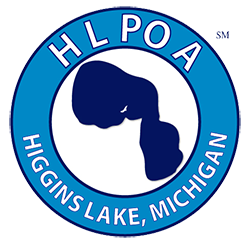Updated DNR Plan — Control of Aquatic Invasive Species (AIS) in Higgins Lake:
Attached below is the updated plan from the MI DNR Dept of Parks & Recreation to address the control of Aquatic Invasive Species (AIS) in Higgins Lake.
New 2019 State Boating Law — Aimed at Preventing the Spread of Aquatic Invasive Species (AIS):
New Requirements for Michigan Boaters and Anglers to Prevent the Introduction and Spread of Aquatic Invasive Species
Michigan’s Natural Resources and Environmental Protection Act (Act 451 of 1994) Part 413 has recently been amended with changes for boaters and anglers that take effect March 21st, 2019.
The changes are intended to strengthen protection for Michigan waterways against the introduction and spread of aquatic invasive species.
Prior to the amended changes, the law only required that a person not place watercraft or trailers in the waters of Michigan if an aquatic plant is attached. In addition to this requirement, the new changes require all of the following prior to transporting any watercraft over land:
- Removing all drain plugs from bilges, ballast tanks, and live wells
- Draining all water from any live wells and bilges
- Ensuring that the watercraft, trailer, and any conveyance used to transport the watercraft or trailer are free of aquatic organisms, including plants
This means that after trailering boats, and before getting on the road, boaters must pull plugs, drain water, and remove plants and other debris. Additionally, the new amended law also incorporates requirements from Michigan’s Department of Natural Resources’ Fisheries Order 245 that will also help to prevent the introduction and spread of aquatic invasive species as well as fish diseases:
- A person shall not release bait fish in any waters of this state. A person who collects fish shall not use the fish as bait or cut bait except in the inland lake, stream, or Great Lake where the fish was caught, or in a connecting waterway of the inland lake, stream, or Great Lake where the fish was caught if the fish could freely move between the original location of capture and the location of release.
- A person, who catches fish other than bait fish in a lake, stream, Great Lake, or connecting waterway shall only release the fish in the lake, stream, or Great Lake where the fish was caught, or in a connecting waterway of the lake, stream, or Great Lake where the fish was caught if the fish could freely move between the original location of capture and the location of release.
Violation of the law is a state civil infraction and violators may be subject to fines up to $100.
To comply with the law and prevent the introduction and spread of aquatic invasive species, boaters should:
- CLEAN boats, trailers and equipment.
- DRAIN live wells, bilges and all water.
- DRY boats and equipment.
- DISPOSE of unwanted bait in the trash.
Please click on the link, below, to see the DEQ’s 2-sided card introducing this new state law and what it means to you:
October, 2018 Update on AIS (Aquatic Invasive Species): Starry Stonewort Detected in Higgins Lake This Summer. DNR Fails to Act.
DNR FAILS TO PREVENT SPREAD OF INVASIVE SPECIES IN HIGGINS LAKE
Starry Stonewort was discovered by divers from the Michigan Department of Environmental Quality (MDEQ) in mid July 2018 during a scuba evaluation of DASH boat activities. The DASH boat (Diver Assisted Suction Harvester) is owned by the Higgins Lake Foundation and operates each summer on Higgins Lake to remove Eurasian Water Milfoil. The dive team from the MDEQ returned a few weeks later and did a survey at 33 sites on Higgins Lake checking for the presence of Starry Stonewort. The plant was identified at six locations in Higgins Lake. Three of the locations are the DNR launch site at the West Launch, the DNR launch site at the South State Park and the channel exiting the south park lagoon. The launch site locations were classified as dense by the MDEQ divers. According to the MDEQ divers, the launch site at the South State Park, while under the stewardship of the DNR, is now so dense with Starry Stonewort and Eurasian Water Milfoil that there are no longer any native plants present.
According to the Minnesota Department of Natural Resources website, “Starry Stonewort is spread through the movement of water-related equipment. Fragments can get tangled in trailers, motors, anchors, fabric, footwear, fishing and hunting gear, and inside of a watercraft.” Every watercraft that has been launched at the West Launch and South State Park launch sites this summer has been a potential distributor of invasive species into Higgins Lake. A small fragment of Starry Stonewort can start a new colony.
Understanding the situation that Higgins Lake is facing, the HLPOA asked the Department of Natural Resources Parks and Recreation Division (DNRPRD) on August 17, 2018 to close the West Launch and the launch site at the South State Park until the situation could be evaluated and a plan of action implemented. The request was denied. Unfortunately, boats continue to drag Starry Stonewort into Higgins Lake based on this denial.
It is clear that the DNR launch sites are the access points for invasive species into our lake as is evidenced by the high density of Starry Stonewort that was identified by the MDEQ divers. We suggest that the DNRPRD assume responsibility for the situation that they have created. The HLPOA recommends closing the launch sites until they are completely cleared of all invasive species, followed by the removal of Starry Stonewort from all other known locations in the lake. Given the continuing invasive species entry at the DNR launch sites, it should also be necessary to fund an annual invasive species assessment in Higgins Lake.
The State of Michigan website, updated December 2017 for the Status and Strategy for Starry Stonewort Management, states: “Prevention of new colony establishment is the most cost effective approach to Starry Stonewort management.” The State of Michigan is refusing to protect Higgins Lake by continuing to allow the launching of boats at their known infested launch sites since the middle of July when Starry Stonewort was first discovered. All of us are stakeholders, and all who love and care for Higgins Lake deserve an answer as to why this is being allowed to happen.
The mission statement of the DNRPRD “is to acquire, protect and preserve the natural and cultural features of Michigan’s unique resources and to provide access to land and water based public recreation and educational opportunities.” Sadly, it is clear that unfettered access, and not preservation, is their primary concern.
HLPOA Board, October, 2018
Update, July 2018 – Free Boat Wash Pilot Program:
To assist our members, and anyone bringing their boat to Higgins Lake, fight the spread of Aquatic Invasive Species (AIS), the HLPOA, in concert with the Higgins Lake Foundation (HLF) and the MI DNR, instituted a free boat wash pilot program for 2018. Click on the link, below, for more information on how to take advantage of this program.
Eurasion Water Milfoil:
Huron Pines 2007 Milfoil Survey
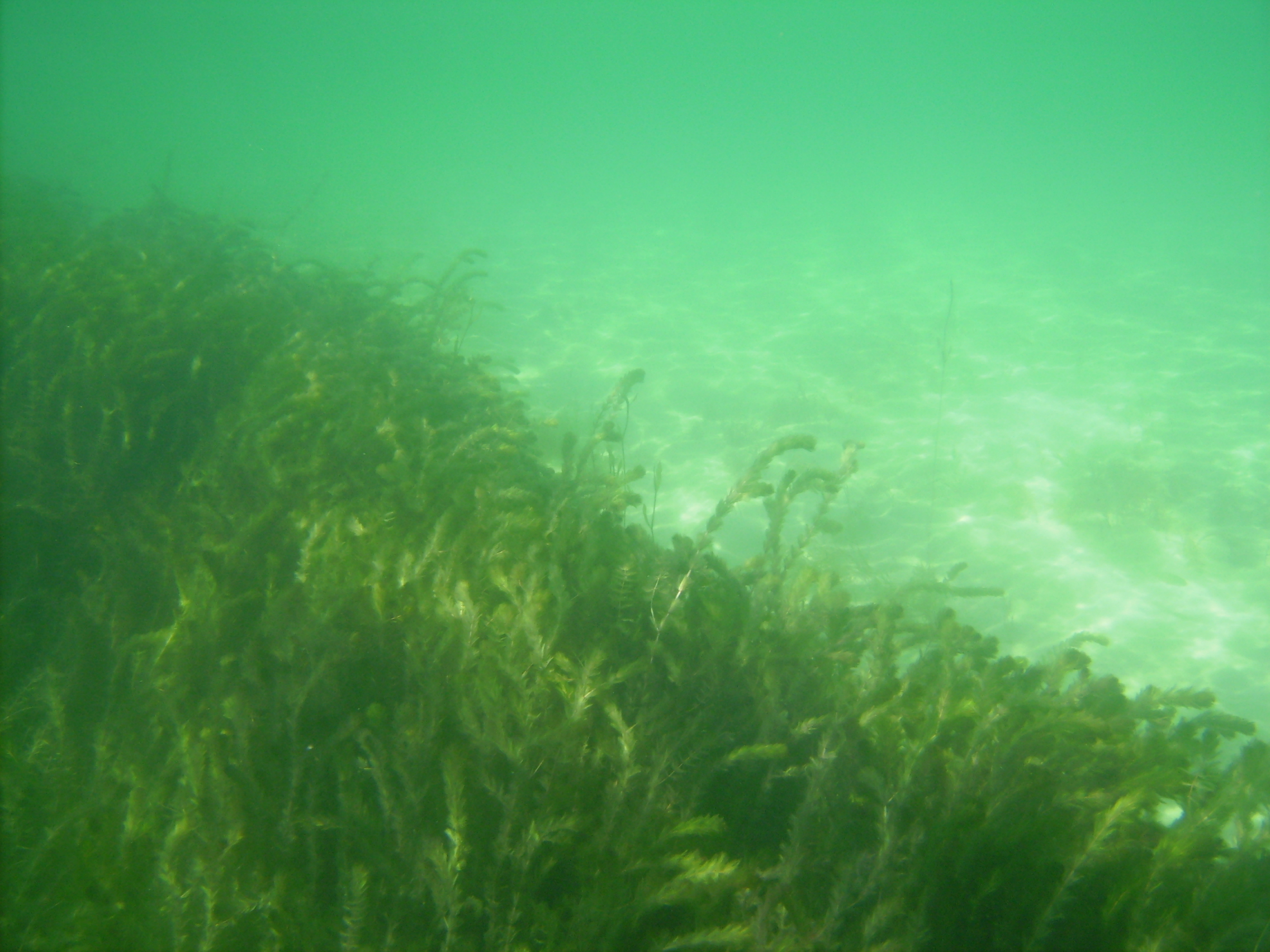

Milfoil growing along the drop-off at Flag Point
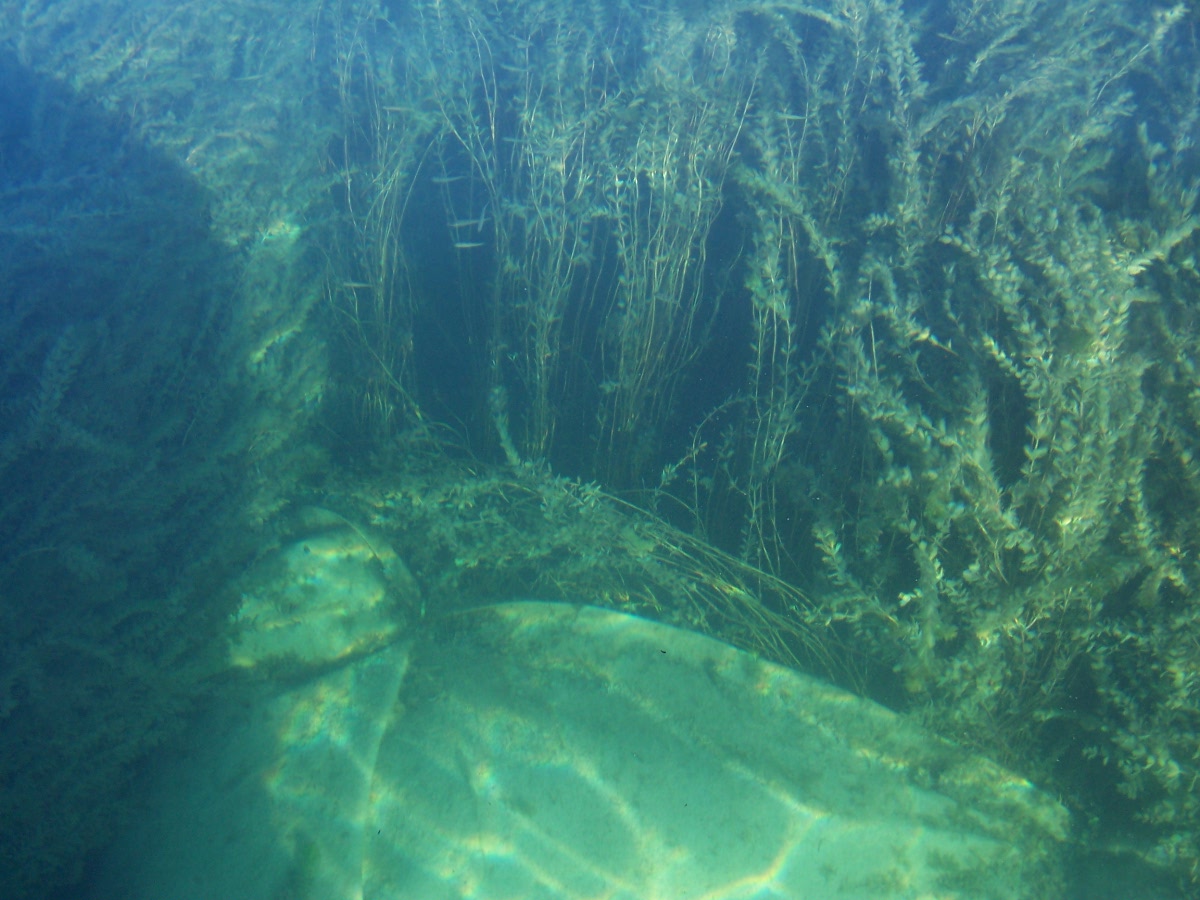
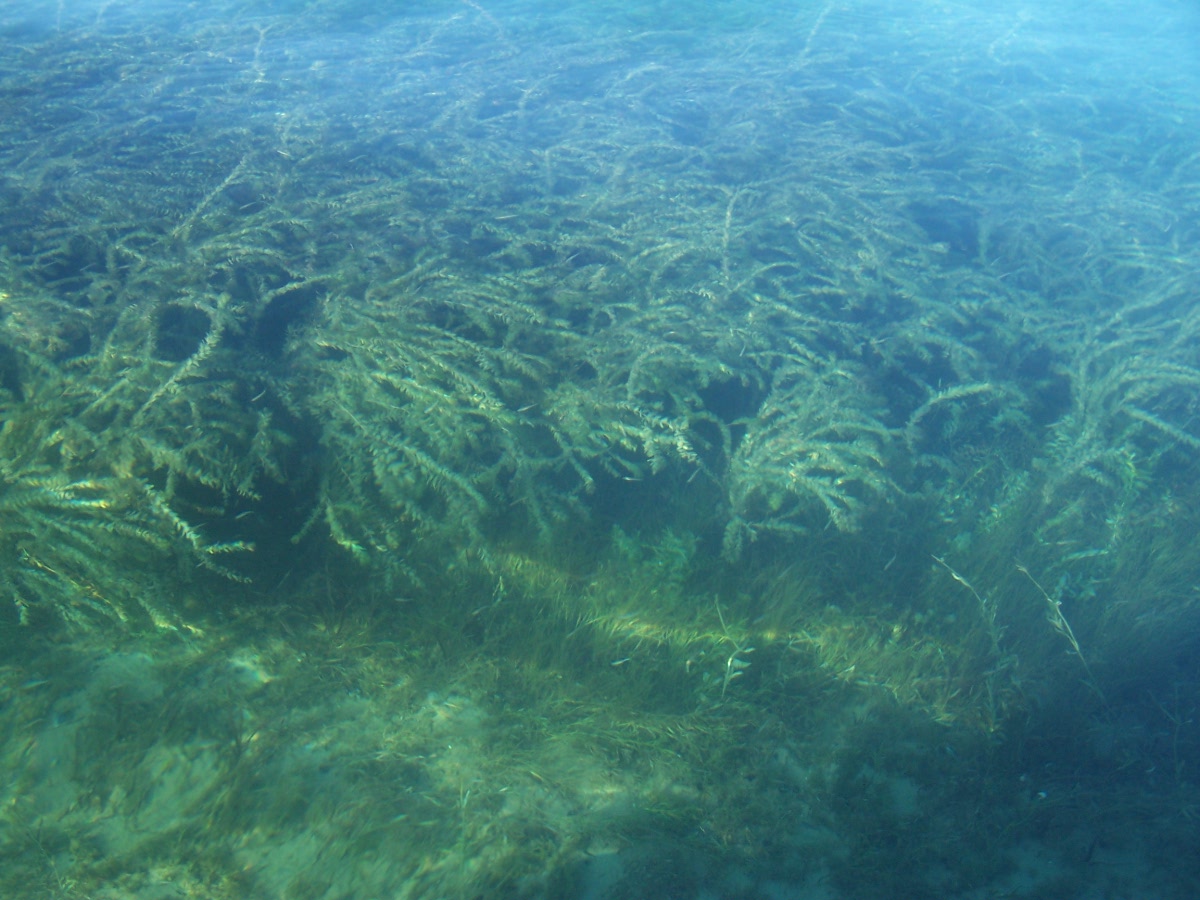
Prolific areas of milfoil near drop-off between Detroit Point and
Old Point Comfort – photo on left shows a barrier next to a wall of milfoil.
Photo on right shows thick patch of milfoil growing almost to the surface
of the lake, and choking out native vegetation.
Huron Pines RC&D Project Fact Sheet July 2004
Higgins Lake: A five star approach to controlling Eurasian watermilfoil
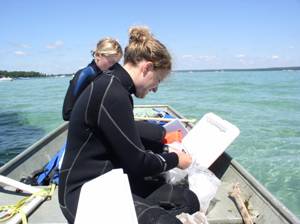
Biologists with Enviroscience prepare to stock milfoil weevils at an EWM site in Higgins Lake
The July 12 stocking of two weed beds in Higgins Lake with the “milfoil weevils” is the latest attack on controlling the spread and growth of Eurasian watermilfoil in order to protect both the lake ecosystem and the recreational opportunities it provides. Eurasian watermilfoil (EWM) is an invasive exotic species thought to have first entered lakes in North America in the 1940s. EWM is a concern because it rapidly colonizes lakes and spreads easily by fragmentation. The plant can grow to the surface of the water and form extremely dense mats, inhibiting boating, fishing and swimming. It also crowds out some of the more ecologically beneficial aquatic plants. Once established, Eurasian watermilfoil is very difficult to remove and can be spread from lake to lake by boat traffic. Higgins Lake is a 9,900-acre high-quality lake located in Roscommon County. The lake, 140 feet at its deepest point, is a tremendous natural resource, attracting thousands of people to live near it and thousands more to visit each year
During the period of June 2001 through December 2002 local citizens, organizations, and resource agencies were involved with developing a watershed management plan for Higgins Lake. As an outgrowth of that project, the Higgins Lake Foundation funded an assessment of Eurasian watermilfoil (EWM). The survey was conducted late June/early July of 2002 by Huron Pines Resource Conservation & Development Council and repeated in 2003. It was conducted in order to identify major EWM weed beds in the lake, characterize the extent of the problem, and provide baseline information for analysis of future management options.
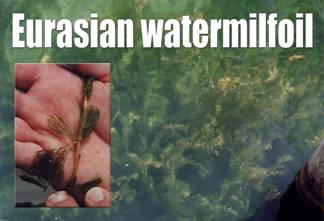 With its sandy substrate and low nutrient levels, Higgins does not appear as susceptible to colonization of EWM as many other lakes in Michigan. Due to the fact that EWM can take hold quickly, addressing these small areas of plant growth is essential to the successful control of EWM in Higgins Lake. In addition, EWM is well established in several sections of the lake. The EWM inventories highlighted 12 priority areas of concern; these areas are the focus of treatment efforts by project partners. These sites include the drop-off areas along Point Detroit and Flag Point, the three major (state-owned) boat launches, a large weed bed several hundred feet from shore between a private marina and Camp Westminister, two sites several hundred feet off Cheney Point, an area where numerous small growths are being established near Treasure Island, a two sites south of Flag Point, and one weed bed between the shore and drop-off in the southwest section of the lake. (For more detailed site information, contact Huron Pines RC&D at 989/348-9319.)
With its sandy substrate and low nutrient levels, Higgins does not appear as susceptible to colonization of EWM as many other lakes in Michigan. Due to the fact that EWM can take hold quickly, addressing these small areas of plant growth is essential to the successful control of EWM in Higgins Lake. In addition, EWM is well established in several sections of the lake. The EWM inventories highlighted 12 priority areas of concern; these areas are the focus of treatment efforts by project partners. These sites include the drop-off areas along Point Detroit and Flag Point, the three major (state-owned) boat launches, a large weed bed several hundred feet from shore between a private marina and Camp Westminister, two sites several hundred feet off Cheney Point, an area where numerous small growths are being established near Treasure Island, a two sites south of Flag Point, and one weed bed between the shore and drop-off in the southwest section of the lake. (For more detailed site information, contact Huron Pines RC&D at 989/348-9319.)
The key to effective control of Eurasian watermilfoil in Higgins Lake is to think in terms of the long-term management of the lake. The course of action should be realistic, cost-effective, and ecologically sound. Due to the unique characteristics of Higgins Lake and the fact that the EWM problem is in its early stages, Huron Pines RC&D staff recommend an integrated management program tailored specifically to Higgins Lake. The involvement and support of community organizations and residents around the lake has made such an approach possible. The strategy, employed one small site at a time, is designed for the long-term health of the Higgins Lake ecosystem, keeping costs – both financial and ecological – to a minimum. The integrated management program, a five-star approach to control of EWM, includes the following: 1) Biological control, 2) Chemical treatment, 3) Physical control, 4) Community Outreach, and 5) Continued monitoring.
Biological control methods, specifically predation of the plant by an aquatic weevil (Euhrychiopsis lecontei), have been successful in many Michigan lakes. This method of control can be expensive initially and time is needed to tell how well a weevil population will sustain itself and provide long-term control; however, this may well prove to be the most effective treatment over time. In the summer of 2002, while collecting some plant samples, biologists with the US Army Corps of Engineers were able to find these herbivores naturally occurring in Higgins Lake. To supplement the natural population, Huron Pines RC&D contracted with the Ohio-based company Enviroscience to stock 10,000 milfoil weevils at two of the more problematic locations in Higgins Lake (Flag Point and the weed bed near between Camp Westminister and B&B Marina). Follow-up study of these two sites during the next three years will help determine whether this method should be used on a greater scale in Higgins Lake. Funding for the weevil project was administered by the Muskegon River Watershed Assembly (MRWA) with project coordination help from the Higgins Lake Property Owner’s Association. A dollar for dollar matching grant, through MRWA’s partnership with the Wege Foundation, allowed local contributions from the Higgins Lake area to get twice as much done for the resource as they otherwise would have been able to. Local contributions came from the Higgins Lake Foundation and the Schroeder Foundation. Also contributing to the effort were The Robert R. Thalner Endowment Fund and the John Morley Family – Higgins Lake Endowment Fund of the Roscommon County Community Foundation.
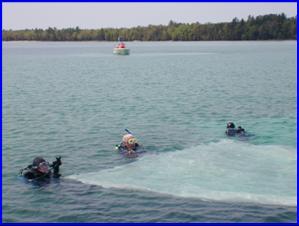
Scuba Divers place a benthic barrier in Higgins Lake
The use of herbicides to treat a lake is a very expensive approach that raises several concerns. These include the immediate effect of the application on non-targeted species, the fact that long-term impacts on all organisms are poorly understood, treatments will likely need to be repeated in future years, and the high potential for re-infestation. “Whole lake” chemical treatment is not appropriate for Higgins Lake because Eurasian watermilfoil is not found in abundant amounts throughout the lake and because of the large volume of water. Limited use of an herbicide for spot treatment at the three DNR Boat Launch sites will be used in 2004 as these public access points seem to be the main entry point for EWM into Higgins Lake. Without eliminating EWM from these three locations, the invasive plant will continue to be introduced into Higgins Lake and efforts to control
its growth would ultimately fail.
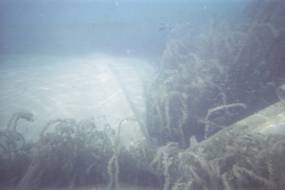
Geo-textile fabric is used in a 2,500 square foot EWM weed bed in Higgins Lake
Physical control, such as the placement of a bottom (or benthic) barrier on the lake bottom, has also been used to control EWM. This is an ecologically sound, low-cost method for small problem areas, although it is labor intensive to install and can be difficult to maintain. By blocking out sunlight, EWM is prevented from growing. This treatment was used in 2003, as a pilot project, at 4 locations in the lake. At three of the four sites in 2003, the treatment worked effectively. At the fourth site, the material was dislodged by boat anchors. (The unsuccessful site was thus targeted for treatment with the milfoil weevils in 2004.) Because of the success of this approach, the treatment was once again used in 2004 at four sites. Through the volunteer efforts of teams of scuba divers, the sites are checked each week and any maintenance work performed as necessary. The material, a geo-textile fabric held in place by stakes and a small amount of rock, was cut into 15’ by 30’ panels for ease of installation by a 3-person team of scuba divers. While the fabric is somewhat permeable, holes are cut into it to allow the escape of gas from bottom sediments.
Note the growth of plants where the barrier is not shading out the plants.
The other form of physical control of EWM, plant harvesting, refers to both pulling the plant by hand as well as using a machine. Because fragmentation of EWM leads to its spread, mechanical harvesting is not a viable option for Higgins Lake. Careful hand harvesting may work in areas where only a small cluster of EWM is present. Once again, EWM spreads through fragmentation, so hand harvesting must be done with the utmost care. All plant fragments should be collected and disposed of off-site. The benefit to this approach, on a micro scale, is that EWM can be prevented from fully establishing itself.
Community Outreach and Education is as important to solving the milfoil problem as any other method of control. Whether it is the use of effective signage at boat launches, the 2003 direct mail distribution of EWM identification cards to property owners, or the 2004 “Look Before You Launch” card pictured below (for distribution at launch sites), all stakeholders that enjoy Higgins Lake need to know that they ultimately play the key role in helping to protect it. Key messages, such as, “Boaters need to wash watercraft and dispose of weeds before entering and exiting Higgins Lake,” are very important for everyone to understand and act on.
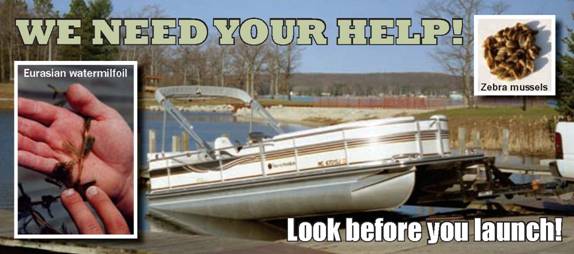
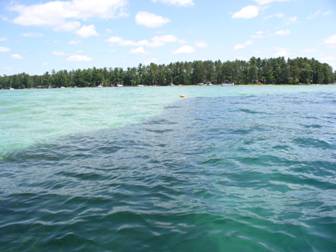
A milfoil weevil treatment site along the drop-off at Flag Point
Continued Monitoring is the final component of the five-star program for managing milfoil. It is vital so that project partners can implement control efforts as soon as EWM if found, before it gets out of hand. The early intervention approach, along with persistence, can ensure the health of Higgins Lake. For more information on identifying or reporting EWM, contact Huron Pines RC&D at 989/348-9319. Because EWM has been documented early on in its infestation of the lake, there is a great opportunity to use a hybrid method of biological control, outreach and education, limited use of chemicals, and physical control techniques to reduce the spread of this invasive plant and help protect Higgins Lake for years to come.

